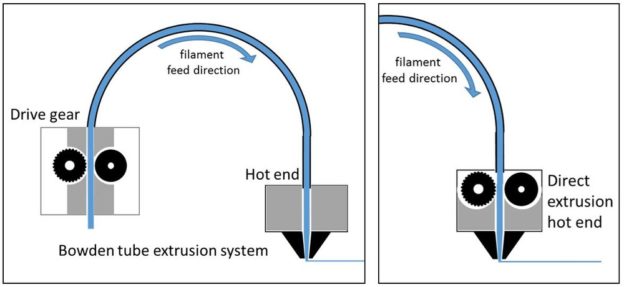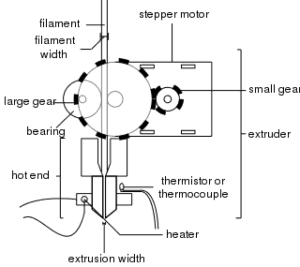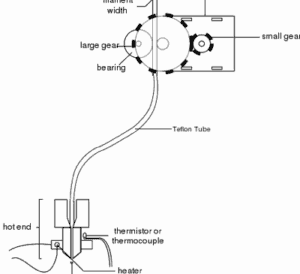Why Are You Here?
You’ve been trolling the 3D printer spaces a bit now and you understand how critical the extruder is to the whole discussion. People keep mentioning the Bowden extruder vs Direct extruder like you know what they are, but you don’t yet, do you? Or, maybe you do, but you don’t really have a solid grasp on the strengths and weaknesses of each? Whatever the scenario you are here, and this is the right place for you because…
I’m about to explain to you exactly what the differences are between a Direct Extruder and a Bowden Extruder with an emphasis on the strengths and weaknesses of each. I’m going to arm you with the knowledge you need to be the best maker you can be.
The DIYers already see how great this knowledge is going to be, but what about the pre-assembled folks? You bought, or you’re buying an assembled 3D printer, you aren’t DIYing this so why should you care? Here’s the thing, knowing what extruder type you are using, and the strengths and weaknesses it brings will allow you to make smart decisions, and software tweaks that will make your prints come out significantly better.
If you don’t take the time to understand what I’m about to tell you then you run the risk of producing sub par prints. All I ask is about 5 minutes of your time and we’ll get you on the way to really producing.
Convinced? If not that’s cool. I’m moving on with the rest of the class.
Quick Extruder Overview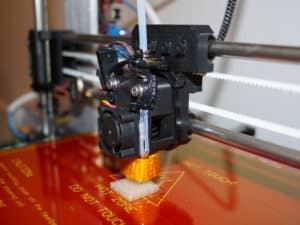
If you don’t know anything about extruders start here. If you already know go ahead and skip to the next section.
The extruder is the heart of the 3D Printer. It pulls in a line of plastic filament, melts it, and lays it out on the print bed where that melted pile of mush becomes the 3D model you dreamed up. It’s a seemingly magical process, but we all know it’s really science and engineering getting the job done.
Here’s the down and dirty on what is happening. There are two major sections to the extruder, the cold end, and the hot end. The cold end pulls filament from the print spooler and pushes it into the hot end where the hot end heats and melts it before pushing it out of a nozzle at precision levels measured in microns.
Extruders are made up of a number of parts. They are made up of the cold end with stepper motors, a hobbed gear, and an idler gear, and the hot end made up of a heatsink and fan, heat break, a heat block, a heater cartridge, thermistor and a nozzle. You don’t need to know about each of those in depth for this article yet, but if you do want to know more about each of those parts check out the extruder section of my Anatomy of a 3D Printer article.
The key I want you to take away is that there are two distinct sections of an extruder, and they each have very specific parts to them.
There are two primary types of extruders. They are the Bowden and the Direct Drive. 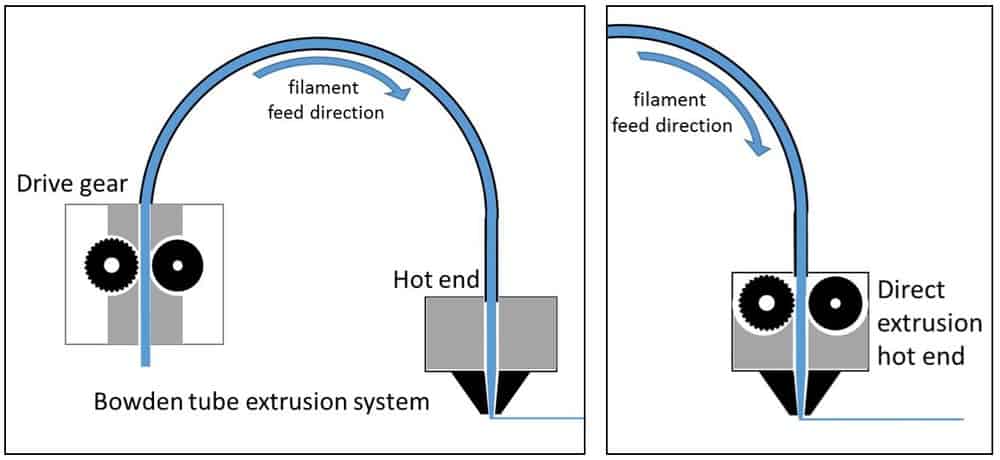
What is a Direct Extruder?
A direct extruder is an extruder where the hot and cold end are attached directly to one another. See how the word direct was used there. It’s like someone used common sense naming this method. Anyway, what I want you to envision here is a 3D print head that is fairly large. The moving portion will have everything listed that makes up the hot end and the cold end. Take that concept away from this section, we will be using it later.
What is a Bowden Extruder?
A Bowden extruder simply moves the cold end to a different location, usually mounted directly to the frame somewhere. The Bowden uses a tube to encase the filament while it is fed a longer distance to the hot end. The moving portion of the printer will now only have the components for the hot end.
The Comparison
OK, so the differences are pretty obvious right, but what are the exact strengths and weaknesses of each? Keep in mind the problems that each has can largely be compensated for with software to a certain degree. As long as you understand the workings of your printer you should be able to produce good prints with both of these extruder styles.
Direct Extruder
The pros though are interesting. Because direct drives have so much control over the filament at the end they allow for more responsive filament feeding. They also maintain tighter control over the filament giving better results with the flexible filament.
All of the problems the direct extruder method has can be attributed to the added weight of everything mounted in one location. It’s all about that pesky inertia we learned about in 8th grade. The extruder has to move to print, and so it accelerates, decelerates, and turns just like a car might. How quickly and accurately it does each directly relates to your print quality.
Pros
- Better responsiveness
- Less torque
- Easier to print more flexible materials
- Less heat to filament motor
Cons
- Backlash
- Overshoot
- Frame wobble
- More heat to movement motors
Bowden Extruder
The Bowden extruder gains the benefit of having less weight so it can move more quickly and take sharper turns with more accuracy. Think of the Bowden as a motorcycle.
The Bowden does suffer from a few problems caused by the lack of control over the filament. The less tightly the filament is held near the hot end the more likely it will have some issues. This means the Bowden does not deal with flexible filaments as well. There is also a lag time when it comes to feeding the filament because of the distance that can cause stringing or oozing.
Pros
- Faster movement
- More precise positioning
- Less movement motor strain
Cons
- More lag in print so increased stringing or oozing
- More filament friction causes difficulty with flexible filament
- Increased strain on filament motor
What to Do?
Oh no!!! They both have problems, what can we do?
*Dramatic Pause*
In reality, these problems are not all that bad as long as you know about them.
For the direct extruder system we want to make sure we have a printer with as stable a frame as possible to handle the extra weight. The software doesn’t know the exact characteristics of your extruder, so the next step is to do some test prints and fiddle with your software settings to change the acceleration and deceleration.
For the bowden extruder system it helps to ensure you have a constrained extruder system, which is a system that gives more control over the filament at the hot end. Next, you do the same testing and software fiddling you would with a direct extruder. You need to figure out how much lag you are getting with the filament you are using to eliminate as much oozing and stringing as possible.
OMG, Which One is Best Already?
If you know me you know I’m going to say it’s situational. The two biggest decision making questions are:
- Are you going to be printing lots of flexible filaments?
And
- Do you need to print quickly?
If you need to print fast go with the Bowden. It will require less tweaking and give you better, more accurate results. If you need to print lots of very flexible filament go with the Direct. It handles flexible filaments better so you will have less system cleaning and tweaking to do.
Either extruder can handle what you want to throw at it, so you aren’t pigeonholing yourself either way. Just know what you are getting into, and how to handle it once you are there and you’ll be happy.
What’s Next For You?
Don’t have a 3D printer yet? Now that you are armed with all this knowledge check out my 3D Printer Reviews to make an informed purchase of your first 3D Printer.
Just want more knowledge to feed into that hungry brain of yours? Check out my Anatomy of a 3D Printer article. It’s the best place to start.

